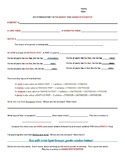
The sonnet has traditionally been used as a way of declaring love, most famously by Shakespeare in his 154-sonnet sequence that dramatized love, beauty, and the passing of time. This fixed rhyme scheme can prompt unconventional phrasing, and gives the sonnet a sense of superiority over conventional speech, whilst at the same time the rhythm of the iambic pentameter keeps it feeling natural. Perhaps the most famous type of fixed verse, the sonnet uses iambic pentameter in a fourteen-line poem, with a rhyme scheme of abab cdcd efef gg. One of the most famous examples is Shelley’s Ode to the West Wind which is a poem written in iambic pentameter (combining an unstressed syllable followed by a stressed syllable in groups of five.) The poem praises the quality of the wind and is a strong invocation of the poet as bringer of political change:

Odes vary in style and form but are nearly always formally structured. The Ode originated in ancient Greece as a way of praising an athletic victory, but later was adopted by the Romantics to convey emotion through intense or lofty language. Odes are short, lyrical poems that are used to express emotions and praise.

The most used, however, are odes and sonnets. Types of fixed verse include limerick, haiku, ballad, villanelle, sestina, and rondeau. #1: Fixed Verseįixed verse poems follow traditional forms, based on formal rhyme schemes and specific patterns of stanza, refrain, and meter. What Are the Basic Poetic Devices of Form?Īgain, there are a huge variety of formal choices open to a poet, but for the purposes of this article we can divide them into three categories: fixed verse, blank verse and free verse. Clever use of poetic form can enhance the meaning or emotion the poet is trying to achieve.

Poetic form refers to how the poem is structured using stanzas, line length, rhyme, and rhythm. Poetic Devices-Formįirst, we’ll look at poetic devices relating to form. There are hundreds, possibly even thousands, of different literary devices open to poets, some of them very obscure having not been used for centuries, and so this article will divide them into categories- Poetic Form, Poetic Diction, and Poetic Punctuation-and concentrate on the most used poetic devices, with examples, in each category.


 0 kommentar(er)
0 kommentar(er)
